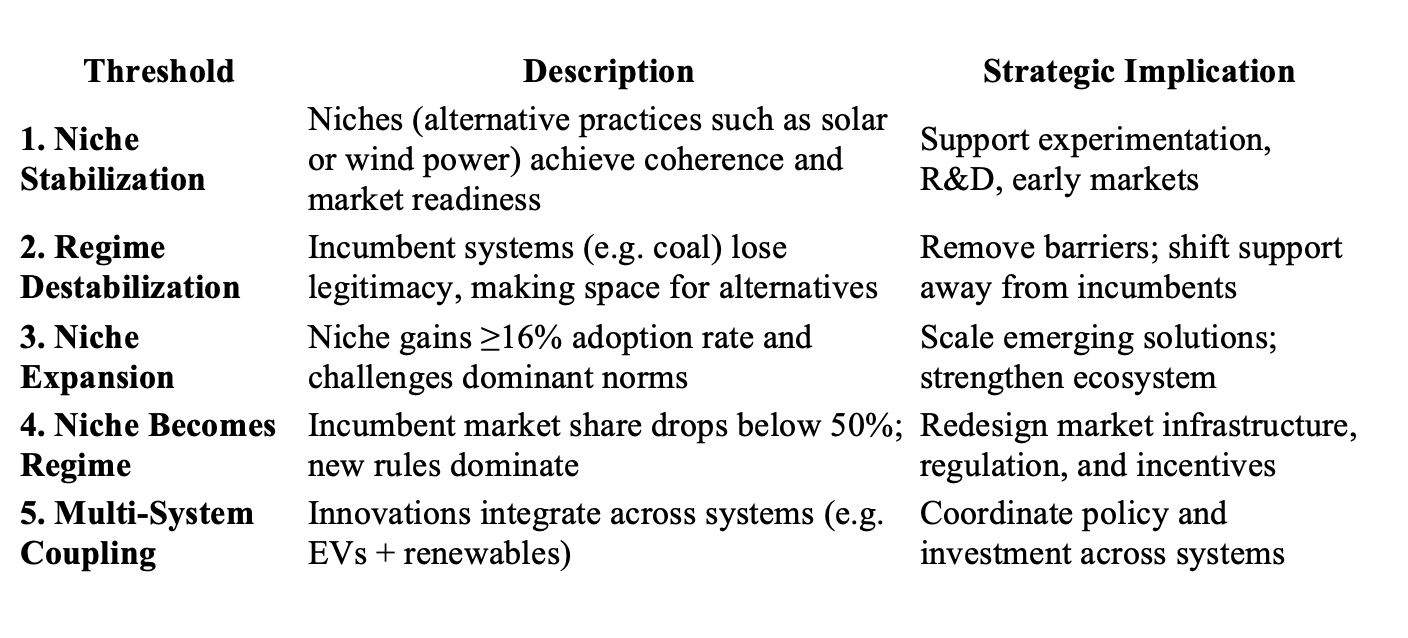Written by
Author
Published on
October 21, 2025
One of the biggest challenge when working in sustainability transitions is knowing how, when, and where to intervene in systems to accelerate change. The paper Exploring thresholds for a double acceleration movement in sustainability transitions by Kejia Yang and Johan Schot offers a structured, practical framework for understanding, tracking, and shaping the acceleration of sustainability transitions. Using China’s energy and mobility transitions as a case study, it introduces five acceleration thresholds and a double acceleration movement to help identify where a transition stands, where it's heading, and what kind of interventions might be needed to accelerate it.

Crucially, the paper proposes measurement tools to assess transition accelerations, not in terms of the diffusion of technological products, but in terms of systemic change. In Deep Transitions (DT) theory, rules are the recurring practices, norms, and institutions that shape our systems —present in our culture (beliefs and values), policy and governance, business and industry, science and technology, and markets. These rules drive fundamental systems change, yet the difficulty is how to measure these changes. In their paper, the authors propose measuring the alignment of actors’ expectations. Once widely shared, such expectations can translate into actions that drive changes in system rules.
By focusing on institutional and rule-based transformation — rather than diffusion of technological products alone — this paper offers a more systemic assessment of transitions providing the reader with an actionable, forward-looking roadmap for managing the complexities of global decarbonisation.
The authors introduce a double acceleration movement, where two processes reinforce each other:
This dual dynamic distinguishes deep transitions from surface-level trends. It highlights that acceleration happens when new visions and rules mutually reinforce one another — creating feedback loops that push systems over tipping points and into new configurations.
To guide action and assess progress, the paper defines five interdependent thresholds that mark the transformation status. Each threshold reflects not just structural change, but a shift in rules. It’s important to note that acceleration is not a strictly linear process. While the first two thresholds need to happen early in a transition, they can be worked on at the same time. Once those foundations are in place, Thresholds 3 to 5 can progress in parallel. This reflects the double acceleration movement central to the framework: as shifts in system rules and actor expectations reinforce each other, transitions can unfold across multiple levels simultaneously — opening up more dynamic and strategic opportunities for action.

These thresholds are not rigid steps but leverage points. Recognising when a system is approaching or passing one allows policymakers and investors to:
China illustrates how these dynamics play out in the real world. In the past two decades, the country has moved through several thresholds.
This transition has demonstrated fundamental system rule changes, not just policy shifts and market rule changes. This process is clearly signalled through the dynamics of actors’ expectation changes— for example, from “coal is inevitable” to “renewables are the future.” These shifts cascaded through passing different thresholds.
For policymakers, this framework provides a practical guide to assess where they are in a transition and what to do next:
For investors, this framework offers a practical way to spot when a sustainability transition is gaining momentum — and where targeted action could accelerate change. By identifying five key thresholds in how systems evolve (such as when niche initiatives like solar and wind energy become mainstream), the paper helps investors assess when a market is nearing a tipping point. This can inform not only the timing and nature of investment decisions, but also where complementary actions — like engagement, advocacy, or philanthropic support — to help pass a threshold.
Transitions don’t just accelerate because of price signals or policy wins. They gain momentum when expectations shift — when people, institutions, and industries start acting as if a different future is not only possible, but inevitable.
That’s why narratives matter. A shared vision of change doesn’t just describe the future — it helps make it real. It aligns decisions, guides investments, and gives individuals a sense of agency within a broader transformation.
This paper provides a strategic framework for navigating the complexity of accelerating real-world transitions. By focusing on thresholds, expectations, and system rules, it allows decision-makers to move beyond reactive policies or market chasing — and instead, to lead.
Post written by Natalie Laurence